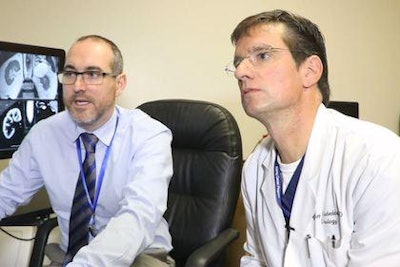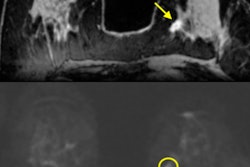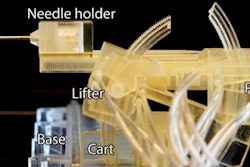
Researchers at the University of Texas (UT) Southwestern have discovered that radiologists using multiparametric MRI (mpMRI) have an 80% chance of detecting clear cell carcinoma in the kidneys without the need for a confirming biopsy. In addition, the technique was successful among radiologists with varying levels of expertise.
The most common type of kidney tumor is smaller than 3.8 cm and is often found incidentally on CT scans performed for other reasons. A biopsy is then performed to determine if the tumor is cancerous.
"Biopsies are not entirely free of pain and discomfort," said study co-author Dr. Jeffrey Cadeddu, a professor of urology and radiology at UT Southwestern. "Some patients, in fact, choose to observe the cancer simply to avoid the pain of the biopsy."
 Study co-authors Dr. Ivan Pedrosa (left) and Dr. Jeffrey Cadeddu (right). Image courtesy of UT Southwestern.
Study co-authors Dr. Ivan Pedrosa (left) and Dr. Jeffrey Cadeddu (right). Image courtesy of UT Southwestern.The cohort included 110 patients with a total of 121 masses. The mean tumor size was 2.4 cm, and 50% of the lesions were clear cell carcinoma.
The mpMRI studies were performed on both 1.5-tesla and 3-tesla MRI scanners at several institutions. Sequences included T2-weighted, axial chemical shift T1-weighted, and dynamic contrast enhanced T1-weighted imaging. Because diffusion-weighted MR images were routinely acquired at UT Southwestern -- but not always at other facilities -- the researchers did not evaluate results using that sequence (Journal of Urology, October 2017, Vol. 198:4, pp. 780-786).
Seven radiologists independently reviewed the results; the radiologists had different levels of experience and were blinded to the final pathology findings. Their task was to rank the likelihood of clear cell carcinoma on a six-point scale, with 1 as "definitely not" cancer and 5 as "definitely" cancer.
By setting a parameter score of 4 or greater for clear cell carcinoma, the researchers achieved sensitivity of 78% and specificity of 80%. With a score of 3 or greater, sensitivity increased to 95% but specificity slipped to 58%. Interobserver agreement was moderate to good with a mean of 0.53.
"Using mpMRI, multiple types of images can be obtained from the renal mass and each one tells us something about the tissue," said co-author Dr. Ivan Pedrosa, a professor of radiology and chief of MRI, in a press statement. "Using mpMRI, doctors at UT Southwestern have a four-in-five chance of identifying clear cell cancer."
For patients, the goal is to help them "avoid the anxiety and the fear and the rare, but possible, complication of a biopsy," Cadeddu said. By doing so, "I think we're pushing medicine forward."




















